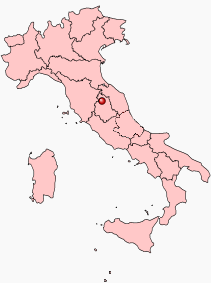| This article needs additional citations for verification. Please help improve this article by adding citations to reliable sources. Unsourced material may be challenged and removed. Find sources: "Tiberina Republic" – news · newspapers · books · scholar · JSTOR (March 2015) (Learn how and when to remove this message) |
| Tiberina RepublicRepubblica Tiberina (Italian) | |||||||||
|---|---|---|---|---|---|---|---|---|---|
| 1798–1798 | |||||||||
 Flag
Flag | |||||||||
 Map of Perugia within modern Italy Map of Perugia within modern Italy | |||||||||
| Capital | Perugia | ||||||||
| Common languages | Italian | ||||||||
| Government | Republic | ||||||||
| • Consul | Angelo Cocchi | ||||||||
| Historical era | French Revolutionary Wars | ||||||||
| • Proclaimed | 4 February 1798 | ||||||||
| • Disestablished | 7 March 1798 | ||||||||
| |||||||||
The so-called Tiberina Republic (Italian: Repubblica Tiberina) was a revolutionary municipality proclaimed on 4 February 1798, when republicans took power in the city of Perugia. It was an occupation zone that took its name from the river Tiber. A month later, the government of all the Papal States was changed into a republic: the Roman Republic, which Perugia belonged to. Its head was a consul and it used a tricolor similar to the French flag.
References
- Cahoon, Ben. "Tiberina Republic". worldstatesmen.org. Retrieved 29 March 2015.
- "Tiberina Republic (1798-1799) (Italy)". crwflags.com. 2 November 1998. Retrieved 29 March 2015.
43°6′44″N 12°23′20″E / 43.11222°N 12.38889°E / 43.11222; 12.38889
| Client states of the French Revolutionary and Napoleonic Wars (1792–1815) | |||||||||||||
|---|---|---|---|---|---|---|---|---|---|---|---|---|---|
| Sister republics |
|  Europe at the height of Napoleon's Empire Europe at the height of Napoleon's Empire | |||||||||||
| Napoleonic creations |
| ||||||||||||
This Italian history article is a stub. You can help Misplaced Pages by expanding it. |